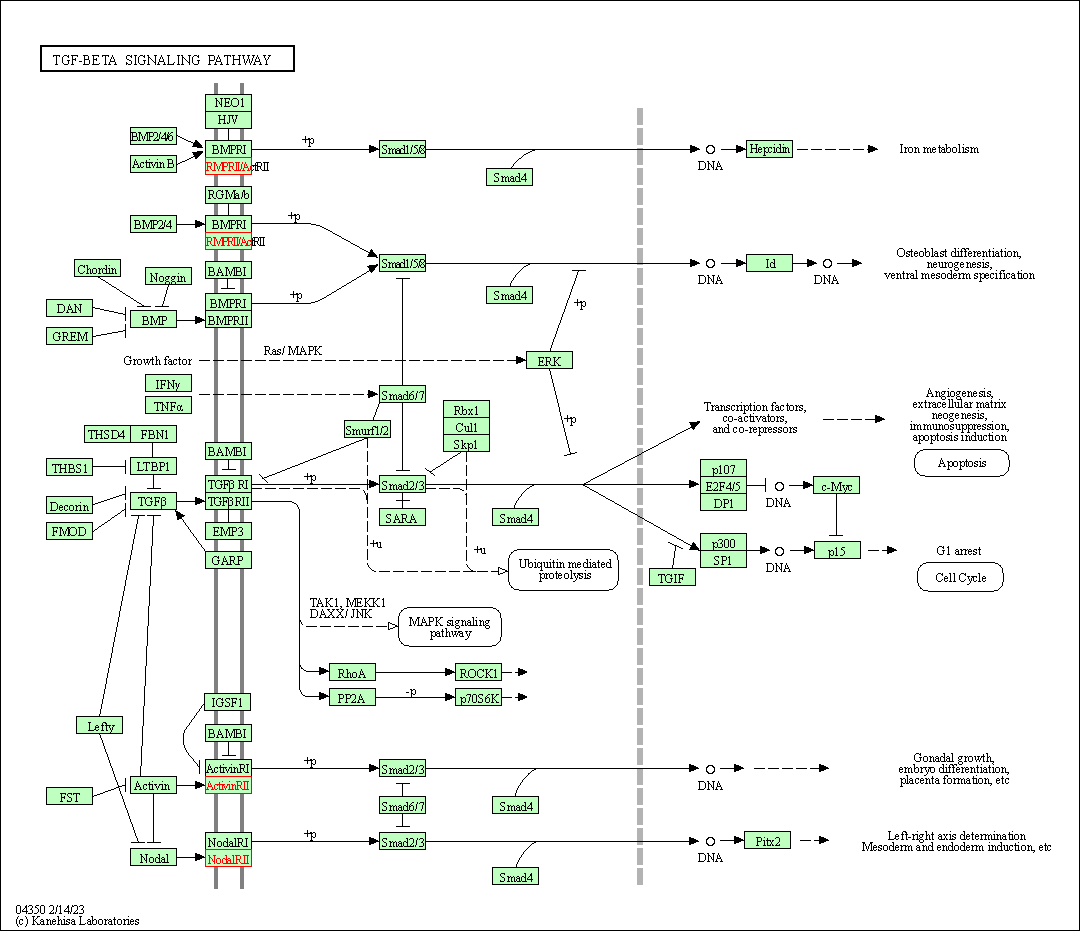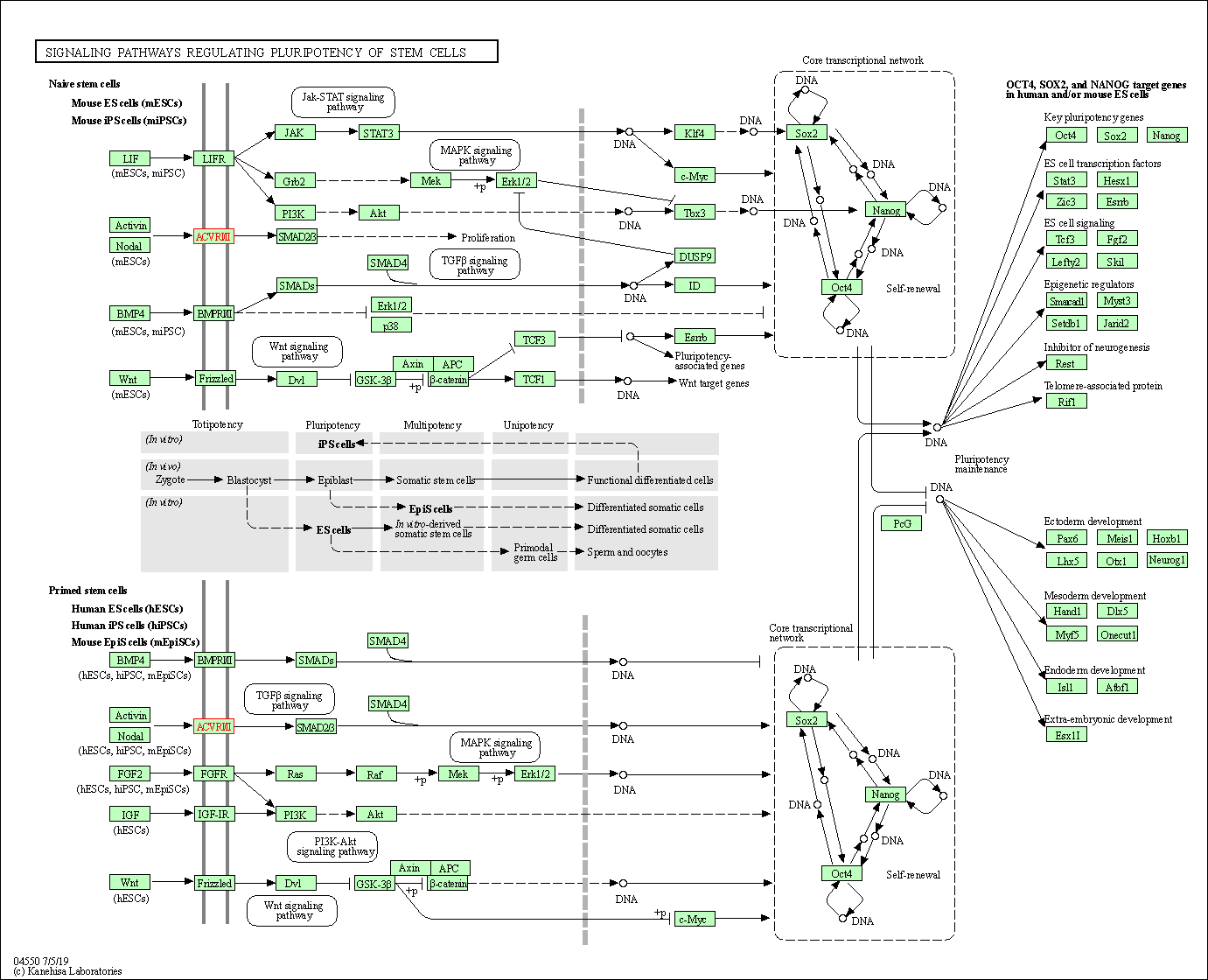Target Information
| Target General Information | Top | |||||
|---|---|---|---|---|---|---|
| Target ID |
T47366
(Former ID: TTDNC00625)
|
|||||
| Target Name |
Activin receptor type IIA (ACVR2A)
|
|||||
| Synonyms |
Activin receptor type2A; Activin receptor type-2A; ACVR2; ACTRIIA; ACTR-IIA
Click to Show/Hide
|
|||||
| Gene Name |
ACVR2A
|
|||||
| Target Type |
Clinical trial target
|
[1] | ||||
| Disease | [+] 2 Target-related Diseases | + | ||||
| 1 | Idiopathic inflammatory myopathy [ICD-11: 4A41] | |||||
| 2 | Acute myeloid leukaemia [ICD-11: 2A60] | |||||
| Function |
Type II receptors phosphorylate and activate type I receptors which autophosphorylate, then bind and activate SMAD transcriptional regulators. Receptor for activin A, activin B and inhibin A. Mediates induction of adipogenesis by GDF6. On ligand binding, forms a receptor complex consisting of two type II and two type I transmembrane serine/threonine kinases.
Click to Show/Hide
|
|||||
| BioChemical Class |
Kinase
|
|||||
| UniProt ID | ||||||
| EC Number |
EC 2.7.11.30
|
|||||
| Sequence |
MGAAAKLAFAVFLISCSSGAILGRSETQECLFFNANWEKDRTNQTGVEPCYGDKDKRRHC
FATWKNISGSIEIVKQGCWLDDINCYDRTDCVEKKDSPEVYFCCCEGNMCNEKFSYFPEM EVTQPTSNPVTPKPPYYNILLYSLVPLMLIAGIVICAFWVYRHHKMAYPPVLVPTQDPGP PPPSPLLGLKPLQLLEVKARGRFGCVWKAQLLNEYVAVKIFPIQDKQSWQNEYEVYSLPG MKHENILQFIGAEKRGTSVDVDLWLITAFHEKGSLSDFLKANVVSWNELCHIAETMARGL AYLHEDIPGLKDGHKPAISHRDIKSKNVLLKNNLTACIADFGLALKFEAGKSAGDTHGQV GTRRYMAPEVLEGAINFQRDAFLRIDMYAMGLVLWELASRCTAADGPVDEYMLPFEEEIG QHPSLEDMQEVVVHKKKRPVLRDYWQKHAGMAMLCETIEECWDHDAEARLSAGCVGERIT QMQRLTNIITTEDIVTVVTMVTNVDFPPKESSL Click to Show/Hide
|
|||||
| 3D Structure | Click to Show 3D Structure of This Target | AlphaFold | ||||
| Drugs and Modes of Action | Top | |||||
|---|---|---|---|---|---|---|
| Clinical Trial Drug(s) | [+] 1 Clinical Trial Drugs | + | ||||
| 1 | BYM338 | Drug Info | Phase 3 | Inclusion body myositis | [2] | |
| Mode of Action | [+] 1 Modes of Action | + | ||||
| Inhibitor | [+] 1 Inhibitor drugs | + | ||||
| 1 | BYM338 | Drug Info | [1] | |||
| Cell-based Target Expression Variations | Top | |||||
|---|---|---|---|---|---|---|
| Cell-based Target Expression Variations | ||||||
| Drug Binding Sites of Target | Top | |||||
|---|---|---|---|---|---|---|
| Ligand Name: Dorsomorphin | Ligand Info | |||||
| Structure Description | Crystal structure of Activin receptor type-IIA (ACVR2A) kinase domain in complex with dorsomorphin | PDB:3Q4T | ||||
| Method | X-ray diffraction | Resolution | 1.96 Å | Mutation | No | [3] |
| PDB Sequence |
LGTENLYFQS
-1 MPLQLLEVKA199 RGRFGCVWKA209 QLLNEYVAVK219 IFPIQDKQSW229 QNEYEVYSLP 239 GMKHENILQF249 IGAEKRGTSV259 DVDLWLITAF269 HEKGSLSDFL279 KANVVSWNEL 289 CHIAETMARG299 LAYLHEDIPG309 LKDGHKPAIS319 HRDIKSKNVL329 LKNNLTACIA 339 DFGLALKFEA349 GKSAGDTHGQ359 VGTRRYMAPE369 VLEGAINFQR379 DAFLRIDMYA 389 MGLVLWELAS399 RCTAADGPVD409 EYMLPFEEEI419 GQHPSLEDMQ429 EVVVHKKKRP 439 VLRDYWQKHA449 GMAMLCETIE459 ECWDHDAEAR469 LSAGCVGERI479 TQMQR |
|||||
|
|
||||||
| Ligand Name: [4-({4-[(5-Cyclopropyl-1h-Pyrazol-3-Yl)amino]quinazolin-2-Yl}imino)cyclohexa-2,5-Dien-1-Yl]acetonitrile | Ligand Info | |||||
| Structure Description | Crystal structure of Activin receptor type-IIA (ACVR2A) kinase domain in complex with a quinazolin | PDB:3SOC | ||||
| Method | X-ray diffraction | Resolution | 1.95 Å | Mutation | No | [4] |
| PDB Sequence |
LGTENLYFQS
-1 MPLQLLEVKA199 RGRFGCVWKA209 QLLNEYVAVK219 IFPIQDKQSW229 QNEYEVYSLP 239 GMKHENILQF249 IGAEKRGTSV259 DVDLWLITAF269 HEKGSLSDFL279 KANVVSWNEL 289 CHIAETMARG299 LAYLHEDIPG309 LKDGHKPAIS319 HRDIKSKNVL329 LKNNLTACIA 339 DFGLALKFEA349 GKSAGDTHGQ359 VGTRRYMAPE369 VLEGAINFQR379 DAFLRIDMYA 389 MGLVLWELAS399 RCTAADGPVD409 EYMLPFEEEI419 GQHPSLEDMQ429 EVVVHKKKRP 439 VLRDYWQKHA449 GMAMLCETIE459 ECWDHDAEAR469 LSAGCVGERI479 TQMQRLT |
|||||
|
|
LYS198
3.724
ALA199
3.869
ARG200
3.918
VAL206
3.484
ALA217
3.625
LYS219
3.509
LEU247
3.612
THR267
3.608
ALA268
3.112
PHE269
3.389
HIS270
3.078
|
|||||
| Click to View More Binding Site Information of This Target with Different Ligands | ||||||
| Different Human System Profiles of Target | Top |
|---|---|
|
Human Similarity Proteins
of target is determined by comparing the sequence similarity of all human proteins with the target based on BLAST. The similarity proteins for a target are defined as the proteins with E-value < 0.005 and outside the protein families of the target.
A target that has fewer human similarity proteins outside its family is commonly regarded to possess a greater capacity to avoid undesired interactions and thus increase the possibility of finding successful drugs
(Brief Bioinform, 21: 649-662, 2020).
Human Pathway Affiliation
of target is determined by the life-essential pathways provided on KEGG database. The target-affiliated pathways were defined based on the following two criteria (a) the pathways of the studied target should be life-essential for both healthy individuals and patients, and (b) the studied target should occupy an upstream position in the pathways and therefore had the ability to regulate biological function.
Targets involved in a fewer pathways have greater likelihood to be successfully developed, while those associated with more human pathways increase the chance of undesirable interferences with other human processes
(Pharmacol Rev, 58: 259-279, 2006).
Biological Network Descriptors
of target is determined based on a human protein-protein interactions (PPI) network consisting of 9,309 proteins and 52,713 PPIs, which were with a high confidence score of ≥ 0.95 collected from STRING database.
The network properties of targets based on protein-protein interactions (PPIs) have been widely adopted for the assessment of target’s druggability. Proteins with high node degree tend to have a high impact on network function through multiple interactions, while proteins with high betweenness centrality are regarded to be central for communication in interaction networks and regulate the flow of signaling information
(Front Pharmacol, 9, 1245, 2018;
Curr Opin Struct Biol. 44:134-142, 2017).
Human Similarity Proteins
Human Pathway Affiliation
Biological Network Descriptors
|
|
| KEGG Pathway | Pathway ID | Affiliated Target | Pathway Map |
|---|---|---|---|
| Cytokine-cytokine receptor interaction | hsa04060 | Affiliated Target |

|
| Class: Environmental Information Processing => Signaling molecules and interaction | Pathway Hierarchy | ||
| TGF-beta signaling pathway | hsa04350 | Affiliated Target |

|
| Class: Environmental Information Processing => Signal transduction | Pathway Hierarchy | ||
| Signaling pathways regulating pluripotency of stem cells | hsa04550 | Affiliated Target |

|
| Class: Cellular Processes => Cellular community - eukaryotes | Pathway Hierarchy | ||
| Degree | 20 | Degree centrality | 2.15E-03 | Betweenness centrality | 3.18E-04 |
|---|---|---|---|---|---|
| Closeness centrality | 2.14E-01 | Radiality | 1.38E+01 | Clustering coefficient | 2.47E-01 |
| Neighborhood connectivity | 2.01E+01 | Topological coefficient | 1.31E-01 | Eccentricity | 12 |
| Download | Click to Download the Full PPI Network of This Target | ||||
| Target Regulators | Top | |||||
|---|---|---|---|---|---|---|
| Target-interacting Proteins | ||||||
| References | Top | |||||
|---|---|---|---|---|---|---|
| REF 1 | Clinical pipeline report, company report or official report of the Pharmaceutical Research and Manufacturers of America (PhRMA) | |||||
| REF 2 | Clinical pipeline report, company report or official report of the Pharmaceutical Research and Manufacturers of America (PhRMA) | |||||
| REF 3 | Small molecules dorsomorphin and LDN-193189 inhibit myostatin/GDF8 signaling and promote functional myoblast differentiation. J Biol Chem. 2015 Feb 6;290(6):3390-404. | |||||
| REF 4 | Crystal structure of Activin receptor type-IIA (ACVR2A) kinase domain in complex with a quinazolin | |||||
If You Find Any Error in Data or Bug in Web Service, Please Kindly Report It to Dr. Zhou and Dr. Zhang.

